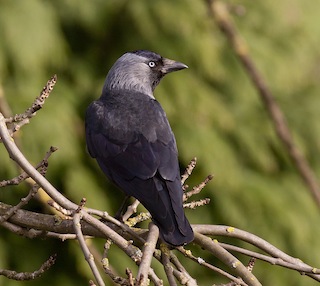 A flock of Jackdaws used to be called a ‘clattering’ – for obvious reasons!
A flock of Jackdaws used to be called a ‘clattering’ – for obvious reasons!
Photo: © Natural England/Allan Drewitt
Scientific name: Corvus monedula
Other common names: Western Jackdaw, Eurasian Jackdaw, Chimney-sweep Bird, Sea-crow
Cornish name: Chogha
Conservation status: UK Birds of Conservation Concern, Green; IUCN Red List, Least Concern
What to look for:
- Colouring and appearance: Looks black from a distance, but is in fact very dark grey, and a distinctly paler silvery grey at the back of its head; pale eye, short bill, black legs. Most often seen in flocks.
- Size: Length 30 to 34 cm, wingspan 64 to 73 cm.
- Where: Throughout the UK, apart from the highlands of Scotland, in woodlands, fields and parks. Also a garden and bird table visitor.
- Call: kak-kak, in flight
 The garrulous and gregarious nature of a flock of Jackdaws makes them impossible to miss if they’re in the neighbourhood. A group of Jackdaws used to be referred to as a ‘clattering’: this seems very appropriate to anyone observing (and hearing) one of the large communal roosts in winter.
The garrulous and gregarious nature of a flock of Jackdaws makes them impossible to miss if they’re in the neighbourhood. A group of Jackdaws used to be referred to as a ‘clattering’: this seems very appropriate to anyone observing (and hearing) one of the large communal roosts in winter.
Their reputation as thieves of bright shiny objects, together with the bold, jaunty movements of the birds on the ground and their bad manners at the bird-table make them appear somewhat vulgar: the ‘Del Boys’ of the avian world. However, these are birds that live in complex social hierarchies of higher- and lower-ranked birds. Males have to establish their place in the hierarchy before mating, and then bond for life: the female adopts her mate’s social status.
 After pairing in their first year, a pair waits to breed until the following year. They build their untidy twig nest in a crevice, whether natural or man-made – chimneys are a favourite! – and defend it aggressively. The female lays a clutch of about four to six pale blue eggs and has sole incubating responsibility, although both parents feed the hatchlings.
After pairing in their first year, a pair waits to breed until the following year. They build their untidy twig nest in a crevice, whether natural or man-made – chimneys are a favourite! – and defend it aggressively. The female lays a clutch of about four to six pale blue eggs and has sole incubating responsibility, although both parents feed the hatchlings.
Jackdaws have a wide distribution across Eurasia and northwest Africa. Apart from the Scottish highlands, they are ubiquitous in the UK, with 1.3 million breeding pairs resident here. Numbers of the UK’s resident birds are swollen in the winter by Jackdaws migrating from Scandinavia. Their diet is varied, and includes insects, worms, small rodents, seeds and berries. They will also steal eggs, and even chicks, from other birds.
Did you know…?
…There are various theories on the derivation of the common name of Jackdaw. ‘Daw’ is the older English name for the species – Shakespeare refers to them as Daws – and can also mean ‘knavish’. ‘Jack’ similarly can mean ‘knavish’, but is also used to mean ‘small’.
…Aesop describes the Jackdaw as the epitome of vanity, dressing itself in the bright feathers of other birds in order to be crowned King, but found out when his ‘borrowed’ finery drops off.
More information and references:
Svensson, L., Mullarney, K., Zetterstrom, D.,1986. Collins Bird Guide, second edition (translated by Christie, D., Svensson, L.). HarperCollins, London.
Websites:
Published: September 2014
Author: Amanda Scott
Photos: upper: © Natural England/Allan Drewitt; lower: Amanda Scott
